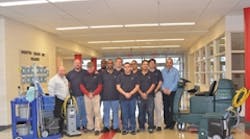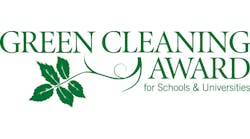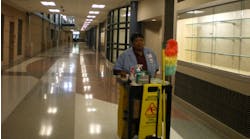GCA K-12/School Districts Honorable Mention
Lower Merion School District, Ardmore, Pennsylvania
PROGRAM INFORMATION
Number of students: 7,682
Maintained square footage: 1,500,000
Number of full-time custodians: 66
Annual cleaning budget: 260,000 (custodial supplies)
Green cleaning team members: Pat Guinnane, Director of Operations; Dennis Witt, Supervisor of Custodians, Safety & Security, Mike Sheehan, Custodial Foreman; Accommodation Mollen, Inc., Franklin Cleaning & Maintenance, Janitorial Product Distributors; Green Council of Lower Merion School District, Community Group
The Lower Merion School District Green Cleaning Program was implemented in 2009 concurrent with the completion of a districtwide capital-improvement program fully modernizing its 10 schools. It was among the first districts in the state to incorporate a comprehensive strategic energy plan as part of the overall strategic plan, including the adoption of a green cleaning program with the long-term goal of meeting complete green cleaning criteria established in "LEED for Existing Buildings" in all buildings by 2013. The program was first introduced in the district’s two high schools before expanding to all other schools and support facilities.
The district takes pride in providing beautiful, aesthetically pleasing facilities, but it does not clean for appearance; the emphasis is cleaning for health. More than 80 percent of its annual budget for cleaning supplies and equipment is earmarked for either Ecologo, Green Seal, or LEED-certified products or the most environmentally friendly or environmentally preferable alternatives. These are applied using innovative best practices to improve overall indoor air quality; reduce exposure to harmful contaminants; reduce particle, chemical and moisture residue from cleaning; and to minimize waste and impact on the environment.
As a public school system, it is conscientious of cost, as taxpayers provide a large percentage of the district budget. Recent advances in green technology have combined sustainability and fiscal responsibility, as the district’s green cleaning program has saved thousands and thousands of dollars over the life cycle of its green equipment and products, while maintaining and improving upon the highest standards of cleanliness.
Moving forward, the district is committed to researching, testing and adopting the most sustainable, environmentally friendly and cost-effective products, technologies and practices available to ensure the most healthful learning and working environments while reducing its ecological footprint.
One major strategy is to begin cleaning efforts at the front door, as the majority of contaminants are tracked into buildings on foot. The district uses LEED-certifiable matting systems to trap dirt and moisture outside the building, in the foyer and inside the school. The mats are manufactured with high levels of recycled materials.
Another strategy to meet its goal is through aggressive cleaning chemical management. All facilities use a chemical management system to ensure proper dilution rates of super-concentrates reducing exposure, consumption, cost, packaging and total environmental impact, while using the most environmentally friendly (EcoLogo, Green Seal certified) products where available. To protect staff, workers are trained by supervisors and vendors to use personal protective equipment (PPE) when handling cleaning chemicals.
•Microfiber technology: To increase cleaning effectiveness microfiber cleaning rags, dust and wet mops are used in conjunction with more ergonomically designed, innovative cleaning tools engineered to trap soil loads with minimal water and cleaning chemicals. For example, the use of a pretreated mopping system cuts clean water and chemical usage by nearly 90 percent, with effectively no water going into the waste stream. To prevent cross-contamination, cleaning tools are color coded to specific cleaning tasks.
•Floor care cleaning equipment: Our fleet includes walk-behind and rider auto-scrubbers that utilize special technology enabling the use of plain water to clean hundreds of thousands of square feet each evening. This technology eliminates chemical exposure and training issues normally associated with floor care, as well as slippery detergent residues, thereby reducing the risk of slip-and-fall accidents. It also uses orbital auto-scrubber technology to allow for restorative floor care without the use of traditional floor strippers. This is a significantly safer and faster process when compared with traditional methods.
•Carpet care: The district uses innovative carpet maintenance equipment, enabling custodians to keep carpets presentable with minimal moisture and cleaning chemical usage. Faster drying times allow them to get right back on the carpets without concern of mold and mildew growth. Carpets are vacuumed using only CRI-approved upright and backpack HEPA-filtered vacuums.
-Hand hygiene: To promote good hand hygiene, the district provides high-quality products that are pleasant to use. In restrooms it uses cost-effective, Green Seal-certified foaming hand soap. Hands-free automatic foam hand sanitizer dispensers are placed strategically near entrances and other high-vector common touch points to reduce the introduction and spread of germs and bacteria.
-Paper products: All paper products meet the U.S. EPA's Comprehensive Procurement Guidelines for post-consumer recycled content and are chlorine-free.
District operations/facilities staff complete mandatory training sessions led by supervisors and vendors on how to safely, effectively and efficiently use all products, tools and equipment. Preventive maintenance agreements maximize the effectiveness of cleaning equipment.
-Ongoing innovation: Years ago the district began using a Green Seal-certified, zinc-free, floor finish throughout the district. Even though the floors look great, custodians were expending significant effort to maintain standards. It is now testing a new floor-care technology on terrazzo floors that dramatically reduces total sustainability impact of floor maintenance. In the past, floors were coated and recoated, requiring many hours of nightly maintenance. This new system enables custodians to hone, polish and treat the terrazzo itself without sacrifice to the appearance and with minimal daily maintenance. The time and labor saved can be reallocated elsewhere, allowing more time for cleaning carpets, disinfecting bathrooms, inspecting classrooms, sanitizing high-touch frequency objects, etc.
The custodial staff is responsible to inspect their own work every day to ensure cleanliness of facilities. Operations staff perform documented custodial quality-control inspections four times a year at each building where everything from exhaust fans to door hinges are examined. The HVAC systems are monitored closely and filters are changed three times a year. Brushes on snow-removal equipment allow for a significant reduction of the amount of ice melt used on sidewalks.
LMSD developed a "Comprehensive Environmental Impact Reduction Plan" encompassing all environmentally related district operational initiatives. Following the EPA's Tools for Schools Indoor Air Quality Programs, OSHA guidelines and other related laws and regulations, the air quality management portion of the plan details the following sub-sections: the storage of cleaning/treatment products, green cleaning program Preventive Maintenance Program (PMP), Integrated Pest Management (IPM), and Idling and Purchasing Policies.
The PMP emphasizes cleanliness and filter effectiveness for the district’s state-of-the-art HVAC systems. As part of this program, dedicated HVAC technicians regularly monitor and adjust ventilation rates in occupied spaces to ensure optimal air quality.
IPM uses procedures to manage structural and landscape pests and the chemicals used for their control in order to eliminate pest problems with the minimal risk to people, property and the environment. An idling policy provides guidelines to reduce idling of school buses and other vehicles while in close proximity with buildings, which is enforced by operations/facilities employees.
The district believes that going green is a districtwide effort, and it is imperative to have students, staff and community as engaged as possible. Operations staff works closely with the Green Council of LMSD to institute districtwide green initiatives, including composting and recycling programs (paper, cardboard, plastic, glass, aluminum, batteries), vegetable and flower gardens, and student-centered awareness programs to reduce wasted resources such "Be Bright, Turn Out the Lights" and "These Come from Trees," a campaign where stickers with this slogan are placed on paper towel dispensers to remind students and staff not to be wasteful. Sustainability is embedded in the curriculum, from kindergartners' explorations of a local arboretum to the unique and extensive green curricular offerings at the high schools.
Last year, LMSD held its first Sustainability Expo in partnership with local green-friendly organizations, vendors and companies to educate students and community members on issues related to energy conservation and air quality, to highlight environmentally friendly practices and to showcase careers in green industries.
Among the many displays and breakout sessions, district officials were on hand to share information on all of our green initiatives and cleaning program.
The operations department recently hosted local chapters of the U.S. Green Building Council (USGBC) and International Facilities Management Association for tours of the new high schools. They highlighted green building features and presented information on the green cleaning program.
Administrators have also been invited to speak at several events, including a presentation entitled "Green Purchasing and Green Cleaning for Schools" to a USGBC seminar and a presentation on "Sustaining Sustainability" at the Pennsylvania Association of School Business Official's conference in Hershey, Pa.
Pennsylvania Congressman Jim Gerlach referred to LMSD as "one of the great green school districts across the country," citing various initiatives and programs which saved roughly $100,000 per year in energy costs while setting the standard for becoming greener and more energy-efficient.



